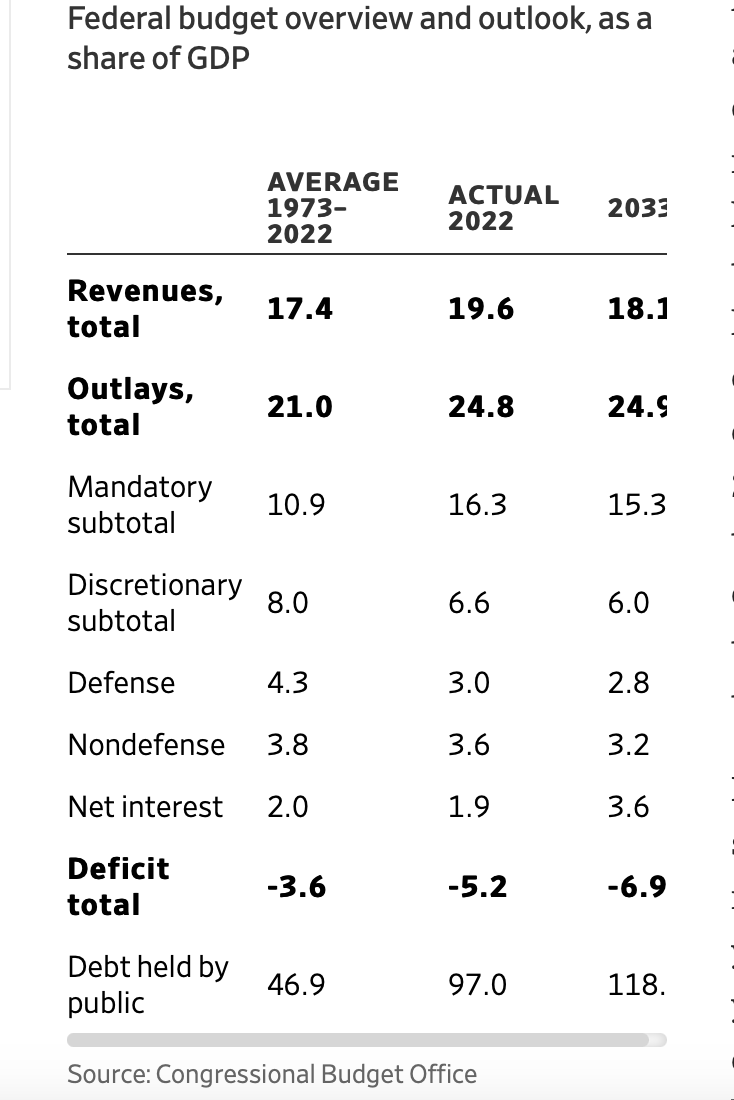By: The Editorial Board – wsj.com – Feburary 15, 2023
The nearby table shows how far the Biden revenue and outlay numbers exceed the U.S. historical norm. Revenues last year hit 19.6% of GDP, far above the 17.4% average over the last 50 years, and a share of the economy reached only in 1944, 1945 and 2000. The overall federal tax burden is higher than ever, and the American taxpayer is paying more than his fair share.
Now look at the spending side of the ledger. Outlays reached 24.8% of GDP last year, far above the 21% 50-year average. Under current law, that spending burden will continue with some modest annual changes more or less through 2033. If you’re a socialist who wants politicians to control more of the means of production, Joe Biden is your man.
The federal spending mix is also notable. Defense spending as a share of GDP fell to 3% last year, far below the 4.3% average. It barely grows for a decade under current law. The only times in history that U.S. defense spending fell this low were in 1940 and 1998-2001. No bonus points for noticing these lows came on the eve of World War II and before the 9/11 attacks. Those defense troughs didn’t last.
Meanwhile, so-called mandatory spending for entitlements (Social Security, Medicare and more) hit a new peak of 16.3% of GDP last year, far above the 10.9% average. That will fall slightly as pandemic programs end, but it will accelerate again later in this decade as more of the baby boomers retire.
And don’t forget interest on the federal debt, which is rising fast again as the Federal Reserve raises interest rates to normal levels. CBO estimates that interest payments will gobble up 3.6% of GDP in a decade, which is based on optimistic assumptions about inflation and rates.
Annual budget deficits will keep climbing as a share of the economy—from 5.2% of GDP in 2022 to 6.9% in 2033 when annual red ink will hit $2.7 trillion. In a single year.
As for the much-discussed federal debt, the nearby chart shows how fast it has grown in the last several years. Debt held by the public—the kind we have to pay back to creditors like the Chinese and Japanese based on contracts—is now 97% of the economy, and will soon rise to 100% and keep going to 118.2% in 2033. How high can it go before creditors stop lending? No one knows, but it will be ugly if they do.
Most of the media will ignore all this because they figure it plays into the hands of Republicans who want to use the debt limit as leverage to gain spending concessions from Mr. Biden. But these are all facts that the public deserves to know. The White House will soon release Mr. Biden’s budget, which will try to prettify all this up so it doesn’t look so spendthrift. CBO’s numbers are a useful reality check.
None of this is fiscal destiny, and we aren’t deficit doomsayers. Much depends on whether Congress can constrain the growth of spending now that Republicans control the House. The other key variable is economic growth, and on that score the CBO estimates aren’t hopeful. It predicts little growth this year, and a rebound only to 2.4% a year from 2024-2027. Growth falls to an anemic 1.8% after that.
***
The bottom line is that the President and the Democrats have built a much larger federal government that is taking nearly a quarter of all national income, up from about a fifth over the last 50 years. Mr. Biden has also raised taxes, though not nearly enough to pay for all of the new spending. He now wants even higher taxes, which he claims will reduce the deficit, though that would really fund even more new spending.
All of this backs the argument made by Republicans to restrain spending growth in everything except national defense. They will have to use their leverage carefully, and with more unity and political savvy than they have shown so far. They do have fiscal reality on their side, for whatever that is still worth.
To see this article in its entirety and subscribew to others like it, choose to read more.
 Listen Online
Listen Online Watch Online
Watch Online Find a Station in Your Area
Find a Station in Your Area









 Listen Now
Listen Now Watch Online
Watch Online
